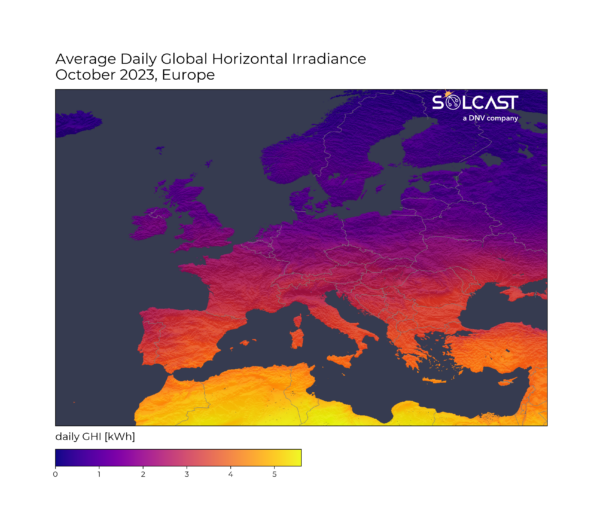Most of Europe saw a continuation of above-average irradiance in the hottest October on record. Solcast analyzed data, via the Solcast API, and found that parts of Italy, Ukraine and Scandinavia saw over 130% of average October irradiance levels despite four large storms that month. The Iberian Peninsula and the land between northern Germany and Poland were hardest hit by storms and saw average or lower irradiance.
October began with clear skies and higher temperatures attributed to a robust high-pressure system over the Alps. The system blocked oceanic moisture from spreading across the continent. In southern Europe, especially around the Black Sea, persistent sunshine led to high irradiance levels. Solar assets from Greece to Ukraine would have recorded an increase of 120% in irradiance levels compared to the typical October average.
Later in the month, low-pressure systems brought clouds and rain across northern Europe. This resulted in lower or average irradiance levels, also moderating the otherwise above-average temperatures. The effects of Storm Babet – which cost the United Kingdom, Germany and the Netherlands over 422 GWh of solar generation – can be seen from the United Kingdom’s east coast to Poland.

The Scandinavian peninsula received much higher irradiance than normal as the low-pressure systems moved farther south than normal, as seen above in the average deviation map. This shifted prevailing winds more north-easterly, bringing colder and drier air masses. This area received less total irradiance than the rest of the continent, as seen below, but many areas across Finland, Sweden and Norway were well above (130%) of the local long-term October average. This was the only Europen area that experienced lower-than-average monthly surface temperatures.
Popular content

Despite the month's sunny start, solar assets on the Iberian Peninsula's west coast were hit hard by all four major storms in October. Portugal bore the brunt of these storms blowing in from the Atlantic, with just 80% of average October irradiance.
Solcast produces these figures by tracking clouds and aerosols at 1 km to 2 km resolution globally, using satellite data and proprietary AI/ML algorithms. This data is used to drive irradiance models, enabling Solcast to calculate irradiance at high resolution, with a typical bias of less than 2%, and also cloud-tracking forecasts. This data is used by more than 300 companies managing over 150 GW of solar assets globally.
The views and opinions expressed in this article are the author’s own, and do not necessarily reflect those held by pv magazine.
This content is protected by copyright and may not be reused. If you want to cooperate with us and would like to reuse some of our content, please contact: editors@pv-magazine.com.


1 comment
By submitting this form you agree to pv magazine using your data for the purposes of publishing your comment.
Your personal data will only be disclosed or otherwise transmitted to third parties for the purposes of spam filtering or if this is necessary for technical maintenance of the website. Any other transfer to third parties will not take place unless this is justified on the basis of applicable data protection regulations or if pv magazine is legally obliged to do so.
You may revoke this consent at any time with effect for the future, in which case your personal data will be deleted immediately. Otherwise, your data will be deleted if pv magazine has processed your request or the purpose of data storage is fulfilled.
Further information on data privacy can be found in our Data Protection Policy.